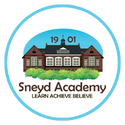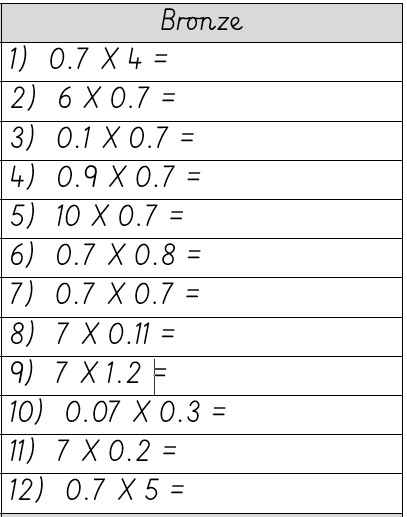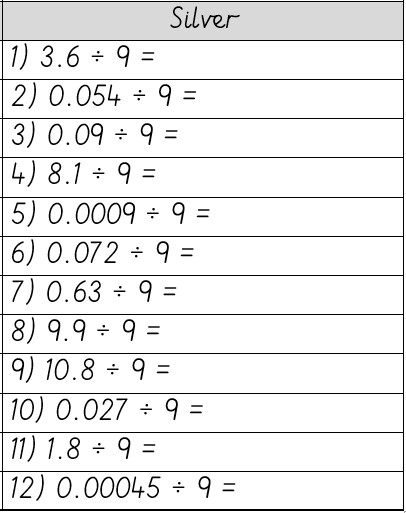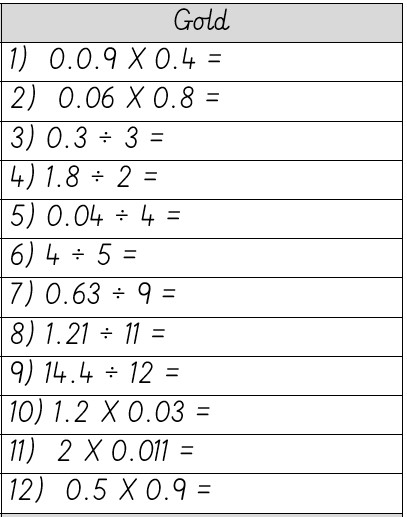Year 6 Mathematics
Curriculum Overview
The mathematics curriculum in Year 6 concludes by ensuring that children have a working knowledge of numbers up to 10, 000, 000 and that they can confidently calculate with whole numbers and decimals using a range of mental and written strategies. By the end of the primary mathematics curriculum, children should be able to draw on a wide range of learned knowledge and mathematical skills to solve a range of contextual problems. They should be able to apply their knowledge across the curriculum and be confident in their own abilities.
Multiplication tables knowledge is consolidated and further extended in Year 6 with our Marvellous Multiplication system extending to teach children to apply simple tables knowledge to tackle derived facts mentally such as 0.06 x 3, 0.7 squared and 0.14 ÷ 7
Children are formally assessed at the end of Year 6 to test their understanding of the primary mathematics curriculum and to determine whether they are working at the level which the government deems acceptable to transition smoothly to secondary education. Children sit an arithmetic test and two reasoning papers in a formal testing environment. Results of these assessments are reported to parents and the DFE. Our school analyses data acquired from these assessments to inform future maths pedagogy and policy.
Below are the National Curriculum objectives which are covered in Year 6.
Year 6 Statutory Requirements
|
NUMBER – NUMBER & PLACE VALUE
- Read, write, order and compare numbers up to 10 000 000 and determine the value of each digit
- Round any whole number to a required degree of accuracy
- Use negative numbers in context, and calculate intervals across zero
- Solve number and practical problems that involve all of the above.
|
NUMBER – ADDITION, SUBTRACTION, MULTIPLICATION & DIVISION
- Multiply multi-digit numbers up to 4 digits by a two-digit whole number using the formal written method of long multiplication
- Divide numbers up to 4 digits by a two-digit whole number using the formal written method of long division, and interpret remainders as whole number remainders, fractions, or by rounding, as appropriate for the context
- Divide numbers up to 4 digits by a two-digit number using the formal written method of short division where appropriate, interpreting remainders according to the context
- Perform mental calculations, including with mixed operations and large numbers
- Identify common factors, common multiples and prime numbers
- Use their knowledge of the order of operations to carry out calculations involving the four operations
- Solve addition and subtraction multi-step problems in contexts, deciding which operations and methods to use and why
- Solve problems involving addition, subtraction, multiplication and division
- Use estimation to check answers to calculations and determine, in the context of a problem, an appropriate degree of accuracy.
|
NUMBER – FRACTIONS (including decimals and percentages)
- Use common factors to simplify fractions; use common multiples to express fractions in the same denomination
- Compare and order fractions, including fractions > 1
- Add and subtract fractions with different denominators and mixed numbers, using the concept of equivalent fractions
- Multiply simple pairs of proper fractions, writing the answer in its simplest form [for example, ¼ X ½ = 1/8
- Divide proper fractions by whole numbers [for example, 1/3 ÷ 2 = 1/6
- Associate a fraction with division and calculate decimal fraction equivalents [for example, 0.375] for a simple fraction [for example, 3/8]
- Identify the value of each digit in numbers given to three decimal places and multiply and divide numbers by 10, 100 and 1000 giving answers up to three decimal places
- Multiply one-digit numbers with up to two decimal places by whole numbers
- Use written division methods in cases where the answer has up to two decimal places
- Solve problems which require answers to be rounded to specified degrees of accuracy
- Recall and use equivalences between simple fractions, decimals and percentages, including in different contexts.
|
RATION & PROPORTION
- Solve problems involving the relative sizes of two quantities where missing values can be found by using integer multiplication and division facts
- Solve problems involving the calculation of percentages [for example, of measures, and such as 15% of 360] and the use of percentages for comparison
- Solve problems involving similar shapes where the scale factor is known or can be found
- Solve problems involving unequal sharing and grouping using knowledge of fractions and multiples.
|
ALGEBRA
- Use simple formulae
- Generate and describe linear number sequences
- Express missing number problems algebraically
- Find pairs of numbers that satisfy an equation with two unknowns
- Enumerate possibilities of combinations of two variables.
|
MEASUREMENT
- Solve problems involving the calculation and conversion of units of measure, using decimal notation up to three decimal places where appropriate
- Use, read, write and convert between standard units, converting measurements of length, mass, volume and time from a smaller unit of measure to a larger unit, and vice versa, using decimal notation to up to three decimal places
- Convert between miles and kilometres
- Recognise that shapes with the same areas can have different perimeters and vice versa
- Recognise when it is possible to use formulae for area and volume of shapes § calculate the area of parallelograms and triangles
- Calculate, estimate and compare volume of cubes and cuboids using standard units, including cubic centimetres (cm3) and cubic metres (m3), and extending to other units [for example, mm3 and km3].
|
GEOMETRY – PROPERTIES OF SHAPE
- Draw 2-D shapes using given dimensions and angles
- Recognise, describe and build simple 3-D shapes, including making nets
- Compare and classify geometric shapes based on their properties and sizes and find unknown angles in any triangles, quadrilaterals, and regular polygons
- Illustrate and name parts of circles, including radius, diameter and circumference and know that the diameter is twice the radius
- Recognise angles where they meet at a point, are on a straight line, or are vertically opposite, and find missing angles.
|
GEOMETRY – POSITION & DIRECTION
- Describe positions on the full coordinate grid (all four quadrants)
- Draw and translate simple shapes on the coordinate plane, and reflect them in the axes.
|
STATISTICS
- Interpret and construct pie charts and line graphs and use these to solve problems
- Calculate and interpret the mean as an average.
|
White Rose
As an academy we structure the delivery of the national curriculum in the order set out by the White Rose and we use a great many of their resources such as the ‘small steps’ to support this delivery. The timetable shows the order in which units of work are taught. Please click here.
Marvellous Multiplications
The Marvellous Multiplication system is a structured system that we use at Sneyd Academy to support children in learning multiplication tables by heart. The system uses a variety of active teaching techniques alongside regular opportunities to rehearse multiplication tables so children become familiar with all multiplication and division facts for each multiplication table. By the end of Year 6 children are expected to know the multiplication and division facts for the 10, 5, 2, 3, 4, 6, 8, 7, 9, 11 and 12 times tables by heart. They should recall these facts confidently and quickly and be able to use them to work out answers to more challenging questions such as 7 x 120 or 0.7 x 12.
Marvellous Multiplications are tested each week within Big Maths sessions. Examples of tests for Year 6 children are below. Children are given 60 seconds to complete each test and apply their knowledge of multiplication tables to derive the answers from known facts.




